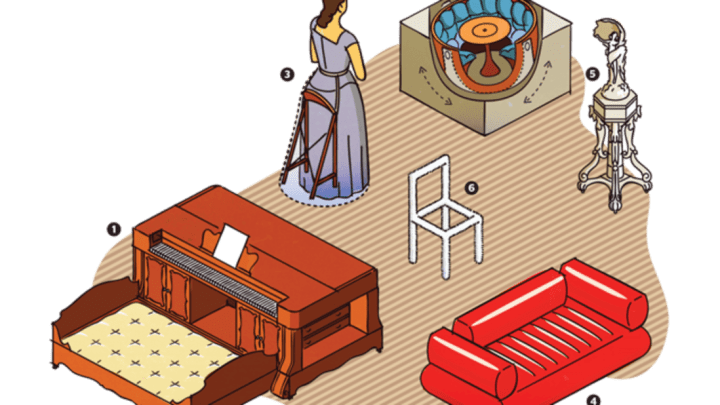Your apartment would look a lot different with this decor.
1. THE SWISS ARMY PIANO
In 1866, Charles Hess designed a piano containing a trundle bed, two closets, a four-drawer bureau, and a sewing area. Hess designed it for hotels and boarding schools, where bedrooms could also be used as daytime parlors. The piano could hold bedclothes, a washbowl, a pitcher, and towels. Meanwhile, the stool doubled as a writing desk and contained a mirror. Lower cabinets held a “lady’s work-box,” complete with needles and a pincushion. Procrastinating before your piano lessons has never been so easy.
2. THE WEEBLE-WOBBLE SOFA
As steamship travel became more popular and affordable in the mid-19th century, a nautical-minded inventor by the name of Newell proposed an “oscillating” couch that kept passengers level as the ship listed over the waves. Looking a lot like the hollowed-out shell of an oversized coconut, the teetering half-sphere was lined with plush cushions and came with its own fixed coffee table. Intended to prevent seasickness, unfortunately, the creation was probably just as likely to induce it.
3. THE WEARABLE STOOL
The popular Victorian bustle protruded from a woman’s backside so far that it made sitting nearly impossible. On the plus side, it made it easy to stow something clunky underneath a lady’s skirt. No wonder Scientific American helpfully proposed in 1887 that women should strap stools to their derrieres to prevent “the fatigue of long standing or walking.” There’s no evidence anybody actually tried to fashion the lifehack, however. After all, you try walking with a stool strapped to your behind.
4. THE INFLATABLE LOVE SEAT
The cheap inflatable accoutrements of a ’90s girl’s bedroom don’t compare to Quasar Khanh’s pioneering furniture from the late 1960s. The Vietnamese designer made everything from a plastic dress to a boxy transparent car, but he’s best known for using air as a building material. His blow-up lounge chairs, which were made in a French beach toy factory, were intended for homes hoping to save space. Instead, they ended up in museums like the Victoria and Albert in London—but you may not sit on the art.
5. THE CONCRETE PHONOGRAPH
Thomas Edison believed that in the future, Main Street would be lined with concrete homes. Edison’s cement houses— which his company could build in a single pour—were clean and “practically indestructible.” And for an extra $200, he’d throw in some concrete furniture, from rock-hard chairs to cement phonograph cabinets. In 1911, Edison told The New York Times that concrete furniture was “more artistic and more durable than is now to be found in the most palatial residence in Paris or along the Rhine.”
6. THE CHEMICAL CHAIR
Japanese artist Tokujin Yoshioka makes furniture that looks (but does not taste) like rock candy. His 2013 “Spider’s Thread” chair was made by tying seven thin strings to a frame and hoisting it above a pool of mineral solution.
Over time, crystals formed and clung to the strings, building a natural chair. It wasn’t Yoshioka’s first time growing crystal furniture. For his 2008 “Venus” chair, he grew a similar seat in a tank by dunking a spongy polyester substrate in a chemical bath. Chemistry has never been so comfortable.
Want more amazing stories like this? Subscribe to mental_floss magazine today!
